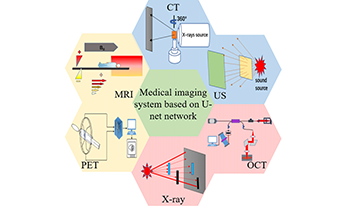
Medical image analysis is performed by analyzing images obtained by medical imaging systems to solve clinical problems. The purpose is to extract effective information and improve the level of clinical diagnosis. In recent years, automatic segmentation based on deep learning (DL) methods has been widely used, where a neural network can automatically learn image features, which is in sharp contrast with the traditional manual learning method. U-net is one of the most important semantic segmentation frameworks for a convolutional neural network (CNN). It is widely used in the medical image analysis domain for lesion segmentation, anatomical segmentation, and classification. The advantage of this network framework is that it can not only accurately segment the desired feature target and effectively process and objectively evaluate medical images but also help to improve accuracy in the diagnosis by medical images. Therefore, this article presents a literature review of medical image segmentation based on U-net, focusing on the successful segmentation experience of U-net for different lesion regions in six medical imaging systems. Along with the latest advances in DL, this article introduces the method of combining the original U-net architecture with deep learning and a method for improving the U-net network.
Getao Du, Xu Cao, Jimin Liang, Xueli Chen, Yonghua Zhan, "Medical Image Segmentation based on U-Net: A Review" in Journal of Imaging Science and Technology, 2020, pp 020508-1 - 020508-12, https://doi.org/10.2352/J.ImagingSci.Technol.2020.64.2.020508
 Find this author on Google Scholar
Find this author on Google Scholar Find this author on PubMed
Find this author on PubMed

